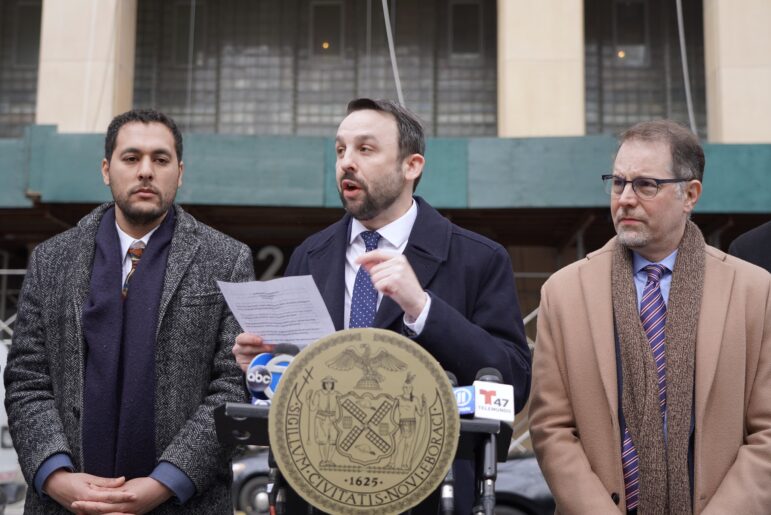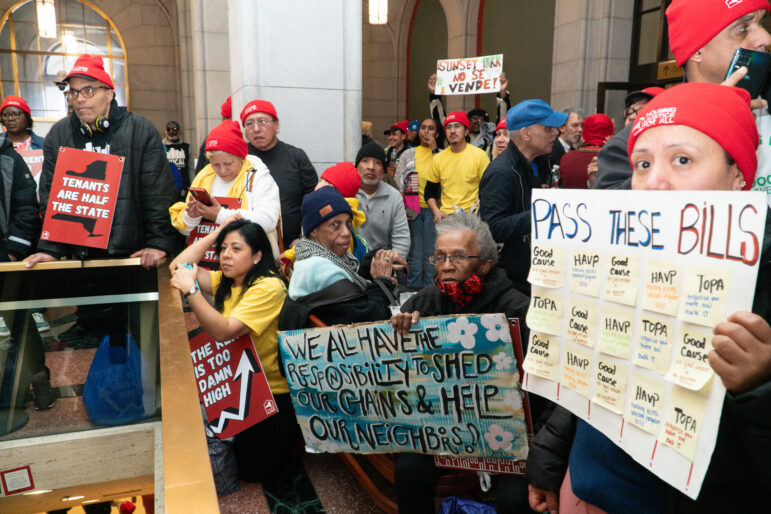
NYC HPD/Jonathan Patkowski
HPD Commissioner Maria Torres-Springer at Wednesday’s tenant rally against a landlord allegedly using bankruptcy proceedings to try to displace tenants.
Here are just a few of the housing related stories that broke in New York so far this week:
1) Tenants and advocates from the Northwest Bronx Community Clergy Coalition planned to rally on Thursday outside a building on the Grand Concourse where they say a landlord has presided over bad conditions and carried out tenant harassment for months. But the protesters concerns stretch well beyond one property. They’re calling for an improvement in conditions at the site – but also for a statewide policy of Universal Rent Control. That phrase that has come to embody both a geographic expansion of current rent-stabilization laws (which wouldn’t help Bronx tenants already covered by it, but could help low-income tenants elsewhere in the state) as well as improvement in the existing rent laws (which would help Bronx renters by eliminating the vacancy bonus and vacancy decontrol, measures that currently can incentivize owners to try to drive tenants out). Unlike marijuana legalization, campaign finance reform, congestion pricing and a host of other policy issues roiling Albany at the moment, rent regulations will likely only be taken up after the state budget is passed in early April. There has been broad agreement among Democrats to tighten the regs, though no unanimity on making them universal.
2) At 11 a.m. on Thursday, the Council’s Oversight & Investigations and Public Housing committees were to hold an oversight hearing on management concerns surrounding NYCHA’s Throggs Neck Houses. Watch live video here.
3) President Trump’s proposed budget drew howls of protest from many New Yorkers citing a host of concerns, but the blueprint’s neglect of local housing needs was a chief complaint. Gov. Cuomo’s office estimated cuts to the Community Development Block Grant and Home programs would have a total impact of $234 million. The $9 billion cut to the U.S. Department of Housing and Urban Development, which oversees Section 8 and public housing, also set off alarm bells—especially given that years of federal underfunding has already created huge problems at NYCHA. “Instead of more money, we get the regional chair of HUD staying in NYCHA developments so that she can see pictures of herself on television and in newspapers,” said Community Voices Heard’s executive director Afua Attah-Mensah. “We need someone who will go to Washington and fight for funding so that the horrible conditions she witnessed first hand can be improved, not someone who engages in a promotional tour to use as reel for a future reality show.”
4) City Planning, Manhattan Borough President Gale Brewer and Councilmember Margaret Chin announced the next “public engagement session” about a possible SoHo and NoHo rezoning: It’s on Wednesday, March 20, at 6 p.m. at the 1 Centre Street North mezzanine.
5) The attorney general and the city and state housing agencies went to Bankruptcy Court to oppose what they characterized as an attempt by a landlord to use the veneer of bankruptcy to tear up leases, evade rent laws and kick tenants out.
6) Bronx Borough President Ruben Diaz Jr. reported that borough saw $3.48 billion in total investment in 2018, a 26 percent leap over 2017. Of the 8,885 housing units that were part of that total, 4,225 were built with government subsidies. That would suggest that less than half of the new housing in the Bronx is income-targeted, which is good news if you’re concerned about the health of the real-estate market there, or if you think income mixing is an important goal for the borough, but bad news if you’re worried about whether the new housing being produced—even in the city’s most affordable borough—is out of reach of residents who need it most.
7) In related news, the city might need to spend more than it plans on NYCHA to comply with the terms of the latest federal settlement, the Independent Budget Office reported. While the current 10-year capital plan sets aside $4.2 billion for NYCHA, including the $2.2 billion required under the deal with HUD and federal prosecutors, “additional support from the city may be necessary if the housing authority is to meet the performance standards the agreement requires.” IBO is careful to note one fact that many observers (especially those intent on chalking up the public-housing disaster solely to Bill de Blasio’s mismanagement) have failed to highlight: “While the city must contribute increased funds, the settlement does not require the federal government to provide any additional support outside its normal, annual capital grant allocation—even though federal funding has failed to keep pace with the housing authority’s capital needs for years.”
8) NYCHA and HPD announced they’d selected Xenolith Partners, The Kretchmer Companies, ELH Mgmt., and the Jewish Association Serving the Aging (JASA) to partner on Casa Celina, a 16-story building comprised of 200 senior units—all income targeted–at Sotomayor Houses in the Bronx and a 13-story building comprised of 154 senior units at Bushwick II (Group E) Houses called Linden Court, built by Blue Sea Development Company and Gilbane Development Company. Both are part of Seniors First, the administration’s senior-housing initiative.
9) The city’s Partners in Preservation pilot anti-displacement program announced its nonprofit partners in three of the neighborhoods affected by rezonings: Community Voices Heard, Tenants & Neighbors, and Picture the Homeless in East Harlem; Northwest Bronx Community & Clergy Coalition and New Settlement Apartments/CASA in the Jerome Avenue area and, in northern Manhattan, the Northern Manhattan Improvement Corporation, Community League of the Heights, Inwood Community Services, and Goddard Riverside Community Center.
10) The City Planning Commission held its first hearing on a plan to build senior housing on about two-thirds of the current footprint of the Elizabeth Garden in Lower Manhattan. In prepared remarks, Councilmember Margaret Chin, who supports the project, said, “Opponents of this project hold a passionate point of view regarding the future of this site. It pains me to disagree with them, especially when I know that we all want what is best for our community. Though they may be less visible, there are many others who hold a different view. I speak regularly with seniors who fully support this effort to bring more safe, accessible and affordable housing to the people of our City. They want to know when it will be ready. Telling them that now is not the time, and that this city-owned lot is not the place, is unacceptable.” Opponents have proposed an alternative site for housing, and have taken issue with the legal grounds for the project—especially the notion that the property is blighted because it is vacant.
11) The City Council approved a suite of bills to reduce the health threat from lead, including several with a potential impact on tenants and landlords. One measures reduced the city’s blood lead reference level to 5 mcg/dL, from its current 10 mcg/dL. Another required “first-draw samples” when lead testing is required by law. A third bill expanded reporting requirements that cover HPD and strengthened auditing of landlord compliance with lead regs, while a fourth requires the the city to “investigate potential sources of elevated blood lead levels in children, including the inspection of any dwelling where a child with an elevated blood lead level spends 10 or more hours per week.”
12) The Council also granted tax exemptions to a 26-unit building at 67-69 St. Nicholas Avenue in Harlem, a 53-unit building on the Lower East Side and a preservation project involving 56 cooperative and rental units in Brooklyn. And the Council approved the “Douglaston Parkway Rezoning” (two developments: an eight-story building and a five-story building, resulting in approximately 83 dwelling units, of which approximately 34 are required to be permanently affordable, and which will be “affordable independent residences for seniors”), a 40-story tower with 100,000 square feet of office space and 100,000 square feet of residential space at 570 Fulton Street in Brooklyn, a 7-story 30-unit building with 4,825 square feet of commercial space in Williamsbridge (in the Bronx) and a 15-story mixed use building with 100 affordable housing units on the site of the Betances V1 NYCHA development.
13) A coalition of advocates joined the Council’s Progressive Caucus in reporting on the city’s performance in implementing 12 bills passed in 2017 to protect tenants—and in concluding that “the City of New York has failed to fully implement the laws and must do better in protecting tenants against predatory landlords that use construction as a tactic to harass tenants.”
14) And as the governor and legislative leaders moved to embrace a pied-à-terre tax on non-resident owners of pricey real estate, the Citizens Budget Commission called the idea “problematic.” One reason? “The proposed tax will have a negative impact on the luxury housing market.” But for some proponents of the tax, that’s part of its beauty: Either the state generates revenue from hyper-wealthy people who buy homes here, or it discourages the kind of luxury housing development that has warped the local housing market. It’s like congestion pricing for real-estate speculators.








